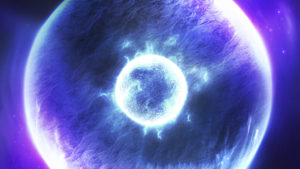


Experimental results obtained in 1879 when conducting electricity through rarefied gases in a vacuum tube and modulated by a magnetic field. From left to right, the tube is filled with nitrogen, oxygen, carbon dioxide and tin(IV) chloride. The positive electrode is on top. The tube with nitrogen produced a spiral, the one with carbon dioxide a set of nine stacked toroids embracing a Y-shaped column. (c) John Rand Capron.
Shots in the Dark Part Two
Mar 28, 2011
The previous Picture of the Day described several of the many myths that refer to a celestial chain of arrows or a celestial ladder. It asked, how is this theme to be explained?
A significant pointer is the realisation that stories concerning the arrow-chain form a subset of the mythology of the axis mundi, the "cosmic column" that occupies such a prominent position in the sacred traditions of most human cultures. Embedded in this larger body of material, the suspicion that the serried arrows mark a specific stage in the temporal development of the column will not be wide off the mark.
When, during the second part of the nineteenth century, physicists began to experiment with electrical discharges in rarefied gases, they soon discovered that a sustained discharge may exhibit striation and take the form of a row of multiple discs or toroids. Perhaps preceded by the little-known Henry d’Abria in 1843, the Welsh judge and physicist, Sir William Robert Grove (1811-1896), first hit upon the phenomenon in 1852. James Clerk Maxwell (1831-1879) himself observed in 1873:
“Some of the forms of electrical discharge through rare gases are exceedingly remarkable. In some cases there is a regular alternation of luminous and dark strata, so that if the electricity, for example, is passing along a tube containing a very small quantity of gas, a number of luminous disks will be seen arranged transversely at nearly equal intervals along the axis of the tube and separated by dark strata. If the strength of the current be increased a new disk will start into existence, and it and the old disks will arrange themselves in closer order. … These, and many other phenomena of electrical discharge, are exceedingly important, and when they are better understood they will probably throw great light on the nature of electricity as well as on the nature of gases and of the medium pervading space.”
In modern terminology, such “luminous disks” are viewed as a type of plasma instability occurring in z-pinches; informally – though not in the published literature – they have been referred to as "Peratt Instabilities," after the American plasma physicist, Anthony Peratt.
Although Maxwell’s expectations were aimed at developments in physics, the analysis of such "stacked toroids" or "nested mushrooms" finds a pointed application in the study of human traditions. Reporting on an extensive set of experiments in 1878, Warren de la Rue (1815-1889) and Hugo W. Müller employed a wide variety of imaginative labels to characterise the Peratt Instabilities they obtained, including “luminosities arranged in serpent-like form," “parallel worm-like entities," “spheroids," “disc-shaped strata," “saucer-shaped strata," “umbrella-shaped strata," and “small crescent-shaped disks of red light," ranging anywhere in number from 2 or 3 to 62. The metaphor of arrows was frequently resorted to as well: an “arrow-headed nebulosity," “luminosities, part of them arrow-headed, arranged in a wavelike formation," “arrow-headed luminosities," “arrow-headed entities," “luminosities with arrow heads arranged in a spiral," and so forth.
John Rand Capron (1829-1888) was an English solicitor and amateur astronomer who generated similar toroids and spirals during electrical experiments he performed around 1879 to prove the electrical nature of the aurorae. Moreover, apparently without exception, myths of the arrow-chain type situate that curious configuration in the sky.
For these reasons, only the most spineless of scholars would forbid that such traditions could be based on a conspicuous electric discharge event directly observed in the earth’s atmosphere on one or perhaps a few occasions in the prehistoric past. The energy required for such a plasma tube to form, to glow and to develop "Peratt instabilities" must have been enormous.
A study of the evolutionary stages that would precede as well as follow that of the nested cones might clinch the matter. De la Rue and Müller had already noted that, under some circumstances, “two disks near the negative join together, assuming the form of a double convex lens," while, under others, “the strata become thicker and fewer; lastly, the current passes with increasing difficulty, and the strata have a tendency to run together.”
Perhaps the latest in a long string of diligent researchers, Peratt has put a firmer backbone into such early researches using cutting-edge technology and simulation software run on the world’s fastest computer. In 2003, he outlined his finding that an initial set of 7 to 9 plasmoids, loosely aligned, will form a rigid "backbone"- or "ladder"- structure under increasing electrical charge. As the current intensifies, the "branches" will begin to warp and merge, until the pinch collapses.
As seen, in the world of mythology, the embedded arrow cones that once led up to the sky run a similar gamut of manifestations and deformations, including the metamorphosis of the pliable string into a rigid ladder or a storeyed mountain and the final disintegration of the latter. With penetrating insight, Peratt also launched the idea that prehistoric petroglyphs categorised as "caterpillars" and "ladders" present visual records of this linear evolution.
The above amounts to circumstantial proof that the earth’s atmosphere once or repeatedly sported a prodigious z-pinch, stratified into an array of discrete plasmoids. With such evidence lined up, the question what unusual physical circumstances could have spawned such a display is surely right on target.
Rens Van der Sluijs
Books by Rens Van Der Sluijs:
The Mythology of the World Axis
The World Axis as an Atmospheric Phenomenon